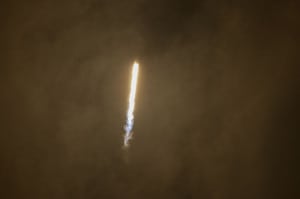Latest News
[Via Satellite 09-03-2014] SpaceX has filed a petition with the United States Patent and Trademark Office over private launch company Blue Origin’s patent for “Sea Landing of Space Launch Vehicles and Associated Systems.” SpaceX asserts in its petition that the technology patented by Blue Origin should be deemed “unpatentable,” followed by arguments against the 15 claims in Blue Origin’s patent. The petition argues that technology which Blue Origin calls specialized ought not be considered so.
In the patent’s abstract (Patent No. US 8,678,321 B2) Blue Origin describes the technology as consisting of “launch vehicle systems and methods for landing and recovering a booster stage and/or other portions thereof on a platform at sea or on another body of water.” This includes embodiments where a Reusable Launch Vehicle (RLV) is first launched from a land-based coastal location over water and, following booster engine cutoff and upper stage separating, the booster then returns tail-first to a pre-positioned sea-going platform. Blue Origin could potentially use this system for its launch vehicle, New Shepard, a Vertical Takeoff-Vertical Landing (VTVL) vehicle capable of carrying manned and unmanned payloads to space, which remains under development.
Following the launch of six OG2 spacecraft for Orbcomm, SpaceX completed a soft-water landing of the Falcon 9 rocket. An airplane, along with cameras attached to the side of the rocket, captured data on the landing before the remainder of the rocket fell into the ocean. SpaceX said in a statement that the company would not attempt reusable landings on AsiaSat 6 and AsiaSat 8 missions because they require too much fuel. The next opportunity is a resupply mission to the International Space Station (ISS), where SpaceX intends to conduct another soft-water landing. But the inability to use a sea-going platform is limiting the company. After this test, the next two launches will attempt to return to land.
Founded by Jeff Bezos, the creator of Amazon, Blue Origin filed the patent in June 2010 and received it on March 25, 2014. The patent lists Bezos, Gary Lai and Sean Findlay as the inventors.
“By 2009, the earliest possibly priority date listed on the face of the patent, the basic concepts of ‘rocket science’ were well known and widely understood. The ‘rocket science’ claimed in the ‘321 patent was, at best, ‘old hat’ by 2009,” SpaceX wrote. “The advantages of landing a reusable launch vehicle at sea have also long been obvious and straightforward to persons of ordinary skill in the art.”
This is not the first disagreement between SpaceX and the normally quiet Blue Origin. When NASA issued its announcement of proposals for leasing Launch Complex 39A, which SpaceX later won, Blue Origin filed a protest, claiming the agency intended “to misapply the terms of the [Announcement for Proposals] AFP in evaluating proposals and selecting a prospective lessee for the facility.” The Government Accountability Office (GAO) subsequently denied the protest, concluding “there currently is nothing in the record beyond the protester’s arguments to show that either approach necessarily is better in terms of meeting the agency’s objective of achieving the fullest commercial use of space.”
For SpaceX, the ability to use a sea-based platform for returning rockets has great appeal. The booster stage of the Falcon 9 contributes to approximately 70 percent of the launch cost, according to Elon Musk, CEO and chief designer of SpaceX. Landing over the ocean removes the need to significantly alter booster trajectory in order to guarantee the rocket can make it back to a landmass. Instead the floating platform could move to the optimal landing location, reducing propellant use and potentially increasing the number of rockets that can be saved, refurbished and reused. Sea-landings also reduce the risk of accidental loss of life or property associated with ground-based landings.
SpaceX drew heavily from Yoshiyuki Ishijima’s ‘Re-entry and Terminal Guidance for Vertical-Landing TSTO (Two-Stage to Orbit),” written in 1998, along with several other documents to support its argument that the technologies in Blue Origin’s patent are nothing new. Claiming that Ishijima’s work and the work of others went “largely unnoticed” during the original prosecution of the patent, SpaceX argues that the examples it cites should be used to requests institution of inter partes review of the patent.
“The prior art references identified in this petition contain pertinent technological teachings, either explicitly or inherently disclosed, that were not previously considered in the manner presented herein or applied during original examination of the ‘321 patent. At least by virtue of disclosing the limitations that served as the basis for the allowance of the claims at issue, the references relied upon herein should be considered important in determining patentability,” wrote SpaceX.
Blue Origin declined to comment on the petition.
Get the latest Via Satellite news!
Subscribe Now